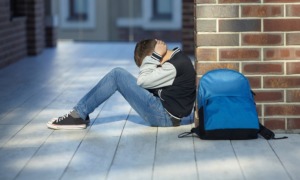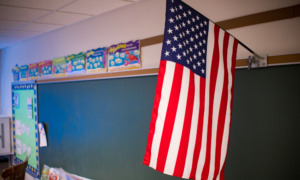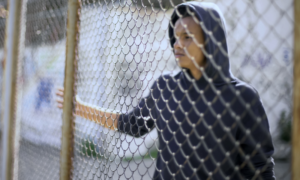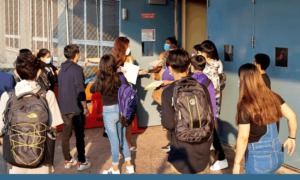
Monkey Business Images/Shutterstock
.
Like it or not, cops in schools are here to stay. The question is: How do we do it right? An important principle for doing it right is driven by this key question: How can we help make sure that law enforcement actually works to keep youth in school and out of justice involvement?
This question is counter-intuitive to some, but the diversion principle behind it has been a major theme of my practice over many years.
Research shows that when a young person is involved in the juvenile justice system they are often negatively affected by the experience. Such involvement interferes with a student’s education, raises the risk of harm to that young person and increases the risk that they will become involved later in life in adult criminal behavior.
One of the ways that school resource officer (SRO) programs should be measured is by looking at how well these school-law enforcement-community partnerships work to divert youth from involvement with the juvenile justice system. Here are five important questions to ask that will drive diversion:
- Has your school and law enforcement community clearly defined the roles the SRO will play?
- Is there a thorough process to select the SRO?
- Is the SRO well-trained?
- Does the school have strong and clear policies related to discipline and diversion?
- Is there a strong partnership with community partners?
Lessons from the field

John Rosiak
What are some examples of how exemplary SRO programs are addressing these five areas for diversion? The following are real-life lessons from school-law enforcement partnerships around the U.S.
Law enforcement agencies and schools may define the roles of SROs differently in different communities. This definition is often determined by what the local community needs and wants. But the activities of each SRO typically involve some combination of a triad of roles: educator, informal counselor/mentor, law enforcement officer. The way each of these roles is carried out has the potential to keep youth out of involvement with the juvenile justice system.
Adam Gongwer, seasoned SRO for the Ontario, Ohio, schools, put it this way: “Under the counselor side of the triad model, diversion strategies like peer mediation, restitution and community service are preferred over citing into juvenile court unless it is an act of violence, or drug- or weapon-related.”
Diversion from juvenile justice is a defined, explicit role of the SRO, according to Joseph Christy, former director of the Washington County Juvenile Department in Hillsboro, Ore. “We never intended for arrests to occur, especially in some of the lower-level offenses like possession of alcohol, minor theft or destruction of property, attendance problems or normal adolescent conflict,” he explained. “This kind of behavior can usually be handled effectively by school administration through mediation, counseling, education and disciplinary practices that balance accountability and respect without elevating it to a criminal violation.”
Typically, defining the roles of the SRO is the result of an interagency discussion. Ed Negron, former captain in the Milwaukee Police Department and now director of safety and security for Milwaukee’s Public Schools, explains how the roles of the SRO are discussed between the superintendent and chief of police: “It was agreed that many matters that SROs are called to address and end up in citations or arrests could be handled at the school level.” This discussion reflects the clarification that school discipline was not the role of the SRO.
The roles of the SRO sometimes evolve with the community’s understanding of how to best achieve community safety. For example, James Franco, former SRO and now director of operations at the Utica, N.Y. Safe Schools/Healthy Students Partnership, explained: “We began to give great thought to the roles of the SRO and how they could actively divert youth from the juvenile justice system when we began to implement the Arrest Diversion Program in our schools in 2010. The program has our SROs acting as front-line personnel actively looking for appropriate cases for diversion. The SROs are critical partners and have seen the results of their diversion efforts over the past five years. They believe in the concept; almost all of our diversion cases are generated by their actions.”
How school-law partnerships select SRO
One of the most important ingredients of a successful SRO program is choosing the right officer. The question communities should ask is: When your school-community goes through the process to choose the SRO, is the concept of diversion included?
Franco recalled that, “Since 2010 the concept of diversion has been used explicitly in the process of choosing SROs. A great deal of thought is given to selecting officers with the right temperament, training and outlook as SROs, and this includes their belief and understanding of diversion.”
SROs are chosen in a variety of ways that may include: Interviews with school administrators, the current SRO and law enforcement commanders — who have the final decision in who is assigned as SRO. Localities can make sure that there is community input in the process, which may include review of the position by the school board, parents and service providers such as behavioral health professionals (who are key personnel to whom an SRO can refer a student).
Is the topic of diversion part of the interview process when a potential SRO is being interviewed? One veteran SRO recently interviewed said that sometimes the question may come up, but there may not be a written policy about diversion. While no one asked him during his interview process about situations where he might divert a student, rather than arrest them, it was probably because those interviewing didn’t know to ask.
The experience in this community raises the point that those doing the selecting may need to consider posing scenario-based questions that reveal a potential SRO’s disposition and skills for keeping students in school, rather than make an arrest.
How the SRO is trained to divert youth
Today’s SRO must receive ongoing training in many different areas. But how is the SRO trained for diversion? More and more SRO programs are training officers in policies and tactics that are aimed at keeping youth in school and out of court. These trainings supplement what all sworn officers are required to learn to carry out their law enforcement job, and teach knowledge and skills that officers need to deal with the youth population in a school setting. This special training provides what Negron calls, “training that assists the officers to better understand what is going on with students and how they might respond appropriately.” SROs need to be trained how to respond to situations where students break school rules by making sure the students are referred to school administrators, not to juvenile court.
Sources of training vary widely and include police academies, peace officer training councils, SRO conferences and online courses. Because of the special nature of the topics SROs need, many pertinent trainings are offered by community agencies, such as mental health providers. Training that supports the SROs’ role in diverting youth from justice involvement takes in a wide variety of topics, including mental health first aid or crisis intervention, adolescent brain development, de-escalating potential situations, cultural diversity and much more.
Policy is another powerful strategy that can be used to enhance the diversion role of SROs. Schools and law enforcement agencies can develop stated policies that help lessen involvement of youth in the justice system. Some SRO Memoranda of Understanding (MOUs) have clear statements that articulate how the SRO relates to school discipline.
Franco points out that Utica’s policy is “designed at reducing the potential ‘school-to-prison pipeline,’ not at enhancing it.” As Gongwer puts it, “Our MOU clearly states that the school administration deals with discipline exclusively. Criminal matters are then reviewed by the SRO to determine the best course of action for both victim and suspect.” School administrators handling school discipline issues in effective ways can increase diversion opportunities.
Policy and training go hand-in-hand. Some law enforcement agencies and schools make sure that SROs are trained to avoid enforcing school discipline policy and focus on actual legal issues. As Franco puts it: “The SRO views an incident primarily as a law enforcement action only when an event is overtly illegal in nature. And even then, they are actively looking to divert those cases that are appropriate.”
Collaboration is essential ingredient to diversion
Defining roles of the SRO, choosing the officer, training and policy — all of these need to be seen in the context of partnership with the broader community. A critical ingredient to an effective diversion effort is strong team collaboration with other partners, including mental health counselors, juvenile justice professionals, school representatives and others.
Christy explains how the community fits in: “The goal was always for the first course of action to be intervention from a team consisting of the SRO, a mental health counselor, a juvenile justice professional and a school representative. The team had broad discretion to engage parents, provide direction, impose appropriate discipline, refer to the right community services. Of course, in cases of more serious offenses or failure of initial interventions, referral to juvenile justice was still available as a course of action, but always as a last resort.”
School-based law enforcement partnerships around the country are taking important steps to help divert students from involvement with the justice system — clarifying the roles of the SRO, selecting the right officer, training for diversion, using policy and partnering with the community. When law enforcement works with schools to divert students from involvement with the justice system, the broader community needs to help by providing the alternatives to which students can be referred to hold our young people accountable and provide them needed supports.
John Rosiak has more than 30 years of cross-sector experience helping school, law enforcement, mental health, juvenile justice and other partners develop effective collaborative efforts around safe and healthy youth. More information can be found at his website, which features the work of the organization he founded, Prevention Partnerships.































